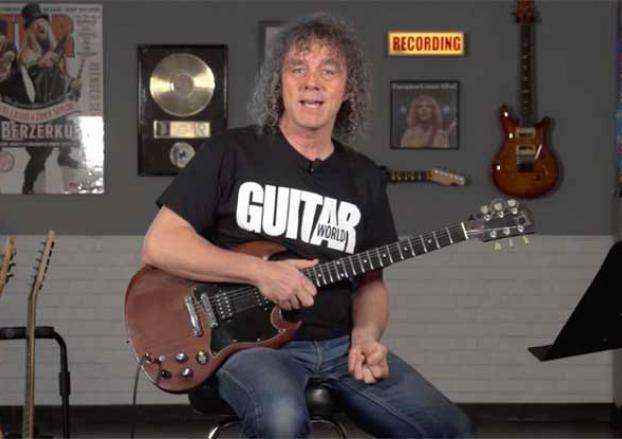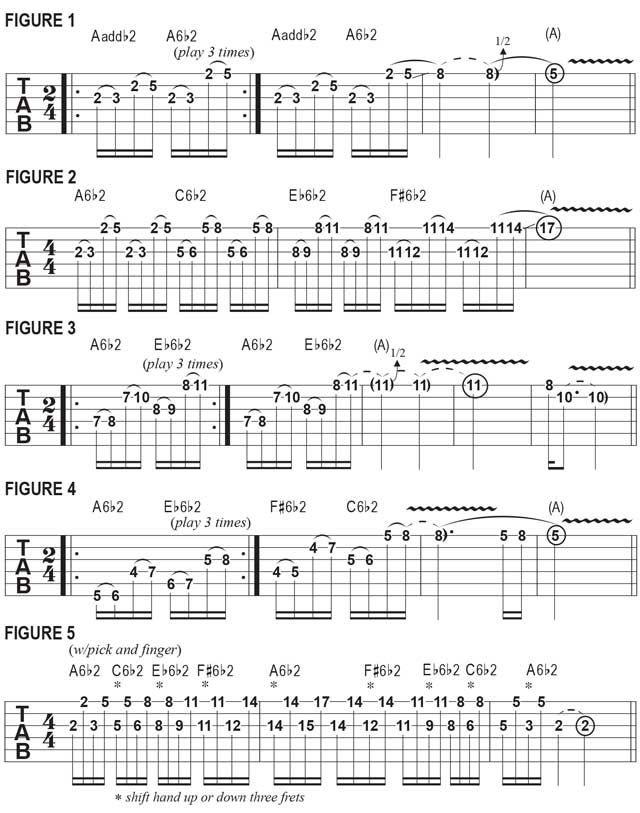Eerie Arpeggios, Part 2:Demented String Skipping

Building upon the eerie-sounding Aaddb2 arpeggio sequence we explored in the previous lesson, I’d now like to offer a variation on this four-note entity that has a similarly haunting vibe while incorporating a wider interval (pitch gap) between the second and third notes, which creates a more angular and interesting melodic contour. What we’ll do here is raise the pitches of the top two notes a perfect fourth, by keeping the fingers at the same frets while moving them over to the next higher string, thus introducing a string skip.
FIGURE 1 is a legato sequence, incorporating every available hammer-on, that begins with the four-note Aaddb2 (A Bb C# E) shape, or “cell,” I introduced last month, which alternates with our new string-skipping shape on beat two of bar 1. With the new shape, instead of playing the notes C# and E (the major third and perfect fifth of A) on the B string again, we’re substituting F# and A on the high E string, fingered at the same frets.
In the key of A, F# is the major sixth, so we’ll call our new arpeggio, which is intervallically spelled 1 b2 6 1 (ending on the root note an octave higher) A6b2 (A Bb F# A), The string skip gives us a major sixth interval, which is rather wide and has a “yodel-y” quality when played melodically. I resolve the sequence with a bluesy lick, sliding up the high E string to the minor third of A, C, which I then bend up a half step to the major third, C#, before pulling off to the A root note at the fifth fret.
In FIGURE 2, we’re taking our yodel-y A6b2 shape and transposing it up the neck in three-fret increments, in symmetrical minor thirds, just as we had done with the Aaddb2 shape in the previous lesson, to create a twisted, slinky-sounding “nightmare run.” Notice that we’re repeating each four-note cell before moving to the next one, which gives our eyes, brains and fingers more time to anticipate each shift.
As was the case with our previous lesson, all the examples I’m showing you here are based on the A half-whole diminished scale (A Bb C C# Eb E F# G) and sound cool when played over an A, A5 or A7 chord or an A bass note. And, again, experiment with reversing the note contour (playing each four-note cell backward), as well as alternate picking with palm muting, for a more aggressive, percussive attack.
In FIGURE 3, I move our A6b2 shape over to the D and G strings and five frets higher, which gives us the same four notes (A Bb F# A), then proceed to do the alternating tritones thing, by moving that same shape up one fret and back over to the G and high E strings. Notice how I resolve the phrase with a bluesy bend and some vibrato.
FIGURE 4 has you initially doing the same alternating tritones pattern from FIGURE 3 an octave lower, using a different physical shape, for which you lead with the middle finger instead of the index. We do that eight-note sequence three times, then move across the strings in bar 2, staying in position and using the index-finger shape again for the last two cells.
All the latest guitar news, interviews, lessons, reviews, deals and more, direct to your inbox!
Like FIGURE 2, our final example (FIGURE 5) moves the A6b2 shape up the G and high strings in minor thirds, but here we’re employing hybrid picking (pick-and-fingers technique) to articulate every note and play a jagged melody that continuously changes direction and skips strings. Be sure to shift your fretting hand as indicated.

Over the past 30 years, Jimmy Brown has built a reputation as one of the world's finest music educators, through his work as a transcriber and Senior Music Editor for Guitar World magazine and Lessons Editor for its sister publication, Guitar Player. In addition to these roles, Jimmy is also a busy working musician, performing regularly in the greater New York City area. Jimmy earned a Bachelor of Music degree in Jazz Studies and Performance and Music Management from William Paterson University in 1989. He is also an experienced private guitar teacher and an accomplished writer.

